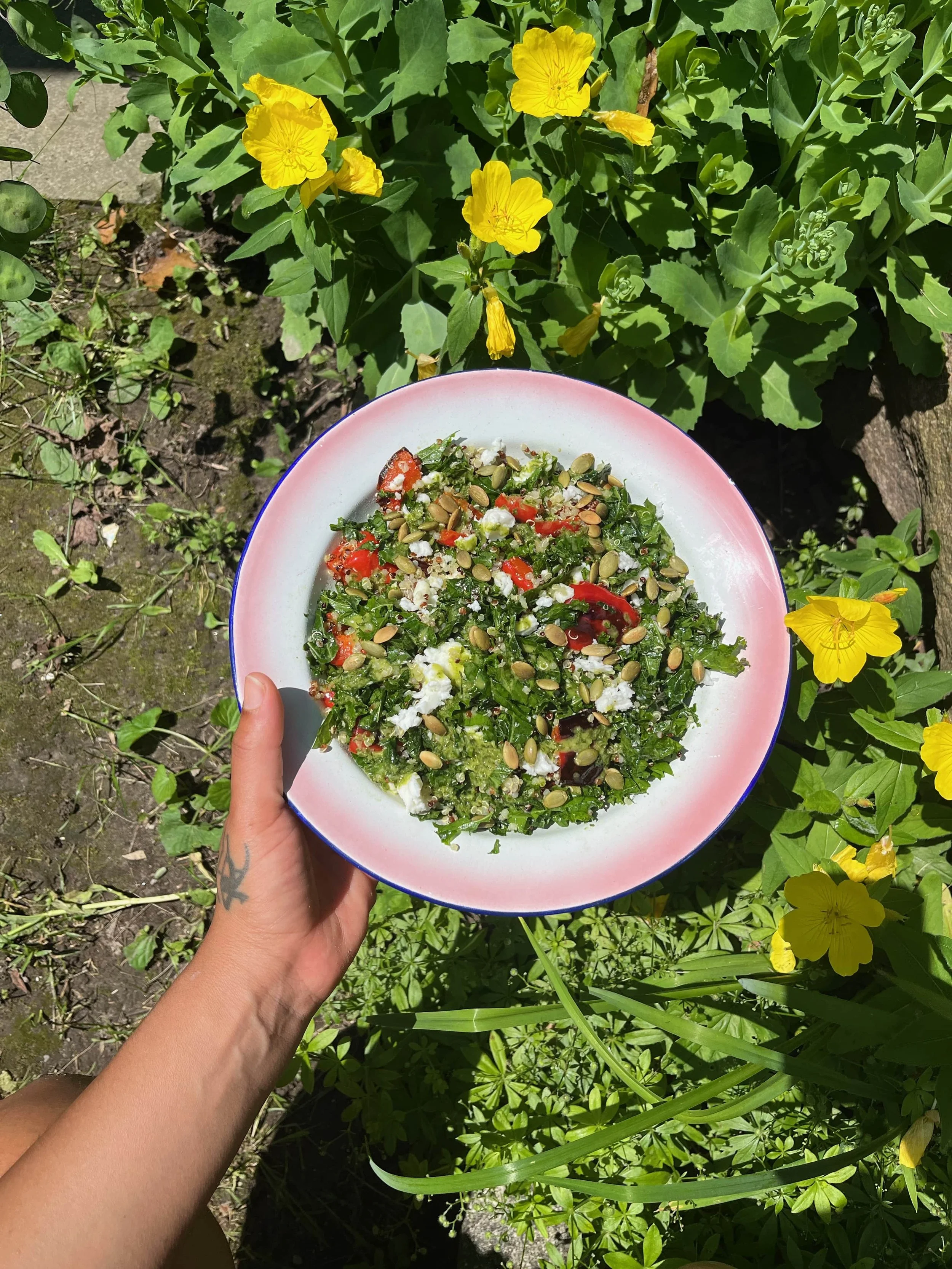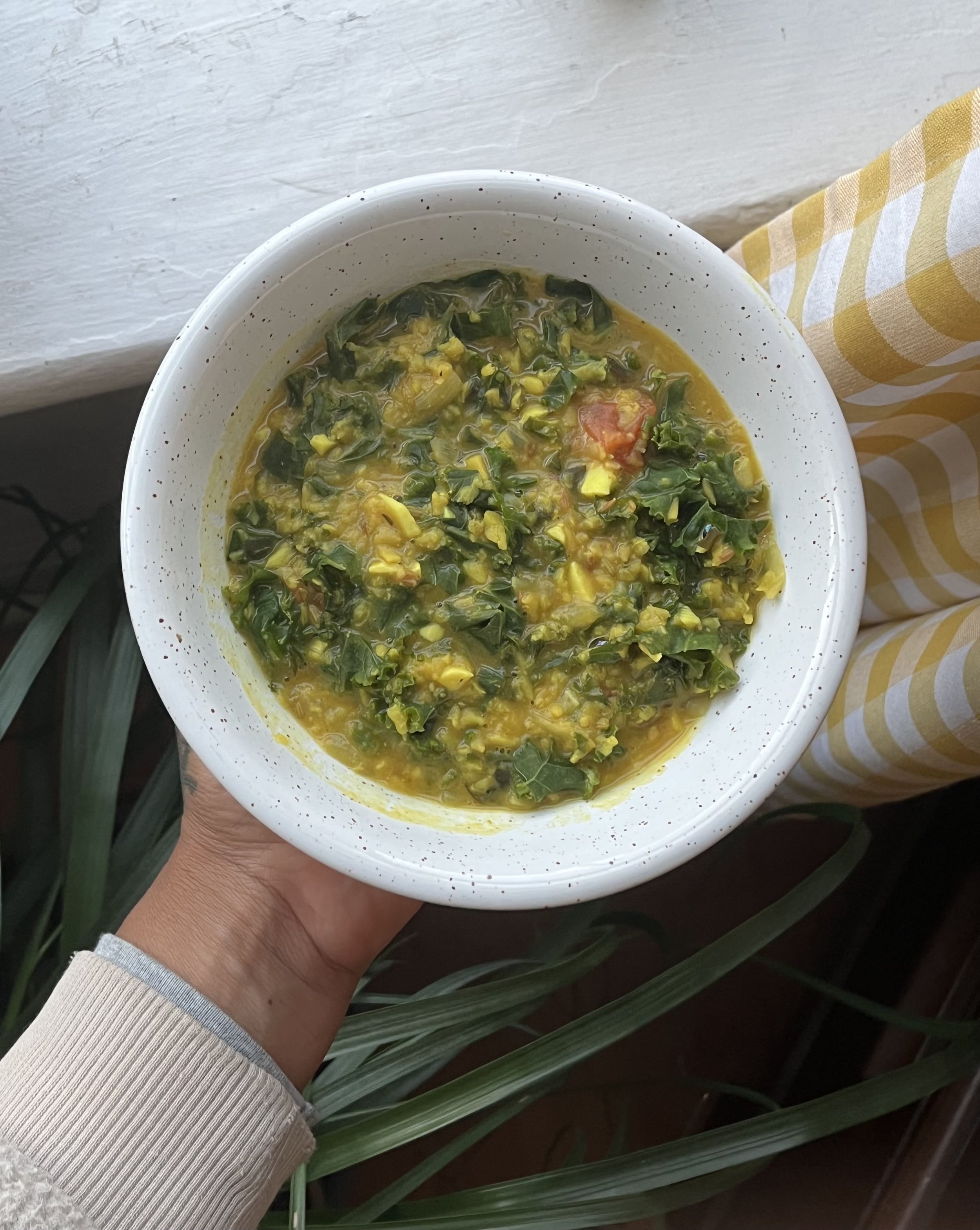GET STARTED
Resources + Tools + Grocery List
↓
WELCOME
MORE
-
Eat an abundance of the foods that nature provides, from the garden, field, and orchard. Natural unprocessed, chemical-free, non-GMO, organic foods give us the vitamins, minerals, amino acids, fatty acids, and phytonutrients that our bodies need to thrive.
-
Water is involved in almost all body functions: circulation, digestion, absorption and elimination. It helps improve our mood, and energy levels and works to combat cravings. Some symptoms of dehydration include fatigue, headaches, irritability, dry mouth, hunger between meals, dark yellow pee, and constipation.
-
The body needs rest to heal from within. Sleep deprivation affects the whole body. When we are physically tired, we feel mentally depleted and our capacity to handle stress diminishes. Prioritize 7-9 hours of sleep daily and work in some restorative rest throughout the week.
-
We are deeply nourished by the sights, smells, sounds, and vibrations of nature. Take advantage of nature’s power to heal by soaking up the sun’s rays, breathing in some fresh air, taking a walk in the park, eating a meal outdoors, and bringing plants and fresh flowers into your home. The more we connect with the natural world, the more we reconnect to our bodies that are part of nature too!
-
Breath is always available to us to help bring us back to centre. Place emphasis on breathing naturally and fully. Most holistic forms of movement place a strong emphasis on breathwork as it is the primary way that energy is encouraged to move in the body.
-
Movement is one of the biggest joys of being in a body! We have been programmed to believe that certain forms of exercise are better than others or we may have forced ourselves to do soulless mindless forms of exercise that take the fun out of it. Move in the ways that you love to, it helps to have a variety of ways that you can be active - yoga, hiking, dancing, group classes, canoeing, gardening/yard work, walking or riding your bike to work - so that it’s more pleasant to incorporate into your daily routine.
-
Connect to yourself, and to others to increase your sense of self, and to feed your soul.
Get in touch with your intuition, needs, emotions, challenges and dreams through meditation, journaling, therapy, and pursuing your interests and hobbies.
Foster reciprocal relationships with your family, friends, and neighbours. Participate in community projects, and collaborations, and support local businesses and food growers.
LESS
-
Artificial ingredients including sweeteners
Bottled/packaged fruit and vegetable juices
Deli meats
Processed oils (canola, sunflower, peanut, vegetable) and transfats
Packaged foods
Fried foods
Fast foods
Frozen foods
-
White breads
White flours
White grains
White sugar and products that contain it
-
Alcohol
Caffeine
Cigarettes
Energy drinks
Soda including diet
Recreational drugs
-
Conventional personal hygiene products (toothpaste, skincare, soap, body wash, lotions and creams, makeup, perfume, deodorant)
Conventional cleaning products (air fresheners, bathroom cleaners, surface cleaners, laundry detergent, dish soap, dishwasher pods)
-
Stress affects us on a mental, emotional, physical, and spiritual level. It has a huge impact on our choices and physiology. Stress is not just anxiety or worry, it also includes physical taxation like blood sugar swings or overexposure to toxins. How does your stress manifest itself and what do you do to cope with it? We can begin to manage our stress by incorporating the 7 pillars of health in the ‘more’ category :)
PROTEIN
-
Wild alaskan sardines
Halibut
Trout
Arctic char
Salmon
Tilapia
Anchovies
Mackerel
Perch
Pickrel
Whitefish
Snapper
-
Chicken (whole bird, thighs, breasts, ground)
Turkey (breasts, ground)
-
Beef (steak, roasts, stewing chunks, ground)
Sausage (filler and preservative free)
Pork (ground, shoulder, chop)
Lamb (ground, chops, loins, shoulder, leg)
-
-
Yogurt (goat or cow)
Goat Cheeses (feta, chèvre, mozzarella, cheddar)
Buffalo Mozzarella
Parmesan
Pecorino
Grass-fed Butter
FRUITS / VEG
-
Blackberries
Blueberries
Raspberries
Strawberries
Apple
Apricot
Avocado
Banana
Cherries
Cranberries
Figs
Kiwi
Mango
Nectarine
Papaya
Peach
Pear
Pineapple
Plum
Pomegranate
-
Lemon
Lime
Grapefruit
Clementine
Tangerine
Mandarine
Orange
-
Arugula
Bok choy
Broccoli
Broccoli rabe
Cabbage
Cauliflower
Collard greens
Dandelion greens
Endive
Kale
Lettuce (romain, red or green leaf, mixed)
Mustard greens
Radicchio
Swiss chard
Spinach
Sprouts: sunflower, pea, broccoli
-
Asparagus
Beets
Bell pepper
Carrot
Celery
Celery Root
Cucumber
Eggplant
Fennel
Green beans
Leeks
Mushrooms
Olives
Onions
Peas
Peppers
Parsnips
Sea vegetables
Snow peas
Sugar snap peas
Tomato
Zucchini
-
Corn
Parsnips
Potatoes
Pumpkin
Sweet potato
Squash (delicata, acorn, honeynut, butternut, spaghetti)
Turnips
-
Basil
Chives
Cilantro
Dill
Mint
Oregano
Parsley
Rosemary
Sage
Tarragon
Thyme
-
Miso
Yogurt
Kimchi
Pickled vegetables
Sauerkraut
PANTRY
-
Garlic
Ginger
Turmeric
Allspice
Black pepper
Carraway
Cardamom
Cayenne
Cinnamon
Clove
Coriander (seed or powder)
Cumin (seed or powder)
Curry (leaves and powder)
Fennel Seed
Garam Masala
Mustard Seed
Sumac
Za’atar
-
Lentils
Split peas
Mung beans
Black beans
Chickpeas
Lentils
Cannellini beans
Navy beans
Kidney beans
Pinto beans
Tofu
Tempeh
-
Chia seeds
Flaxseeds (whole or ground)
Hemp seeds
Pumpkin seeds
Sunflower seeds
Sesame seed
Tahini
-
Almonds
Walnuts
Pecans
Cashews
Pinenuts
Hazelnuts
Coconut
-
Brown rice
Brown rice noodles
Soba noodles
Buckwheat
Millet
Oats
Quinoa
Red, pink or black rice
Wild rice
-
Olive oil
Coconut oil
Ghee
Avocado oil
Walnut oil
Flaxseed oil
Sesame Oil
-
Apple cider vinegar
Champagne vinegar
Red wine vinegar
Rice vinegar
Sherry Vinegar
White wine vinegar
-
Harrisa
Mustards (grainy, dijon, horseradish)
Preserves
Salsa (organic)
Sriracha (organic)
Tahini
Tamari
-
Dates
Dried fruit (cherries, cranberries, apricots)
Applesauce (organic, no added sugar)
Honey
Maple syrup
Coconut sugar
-
Almond Flour
Bee Pollen
Chlorella
Coconut products (milk, cream, flakes, flour)
Nut and seed butters
Seaweeds (nori, dulse, wakame, kombu)
Spirulina
Unsweetened dark baking chocolate
BEVERAGES
-
Municipal tap water is a carrier of toxins, so invest in a good quality filter. Aim for 2 litres a day, your cells with thank you!
-
Green Tea/Matcha
Loose leaf herbal tea
-
Coffee is fine to drink but make sure to have it after you’ve put some food in your stomach. Look for good quality, organic, fair trade coffee - it is a crop that is heavily sprayed with pesticides. Refrain from drinking it past noon to ensure a good night’s sleep.
-
Fresh-pressed fruit and vegetable juices are like liquid multivitamins delivering nutrients straight to your cells without the work of digestion and metabolism.
Two of my favourite combos:
Celery, cucumber, parsley, lime
Beet, carrot, apple, lemon, ginger
-
A nutrient-dense, fiber-rich liquid meal! Be sure to include: protein, fat, fibre, and leafy greens for a balanced cup.
Two of my favourite combos:
Sprouts, pineapple, banana, avocado, coconut water, mint, hemp seeds, chlorella
Spinach, blueberries, banana, date, hemp seeds, flax seeds, almond butter, cinnamon
-
Vegetable broths are mineral-rich, and bone broths are full of amino acids and collagen. Make your own by keeping vegetable scraps (onion, leek, celery, carrot, tender herbs, ginger skins, mushroom stems) and/or leftover bones from roasted chicken. Broths are great to sip on and cook with making soup, stews, legumes and grains more flavourful.
-
Carbonated water (plain or flavoured, unsweetened, no artificial ingredients)
Coconut water
Dandy blend
Kombucha
Nut milk
Prebiotic sodas
Shrubs (vinegar, fruit and herbal concentrates)
TOOLS TO SUPPORT YOU
For a full library of items, visit my Amazon storefront
PODCASTS + PLAYLISTS
-
One Part Podcast Episode 111: The Grandma Principles of Health with Daphne Javitch of Doing Well
The Liz Moody Podcast: Ask the Doctor - Hormone Edition with Aviva Romm, MD
The Superfeast Podcast Episode 146: The Privilege of Wellness with Russel Brown
Pulling The Thread with Elise Loehnen: The Boundaries We Need (Melissa Urban)
-
SOME RECIPES TO SUPPORT YOU
Breakfast
-
This breakfast is my lifeline during busy weeks. The best thing about chia pudding is that you can get the nutrient density of a smoothie but prepare it in a large format that can last up to 5 days, so each morning all you have to do is portion it out and add your toppings.
Some other benefits include liver support from beets, hydrating strawberries, antioxidant and antimicrobial support from coconut milk, and of course the many benefits of chia seeds which include but are not limited to fibre, protein, omega-3’s, calcium, magnesium, and iron.
Toppings are a choose-your-own-adventure deal, but I like to use it as an opportunity to seed cycle, using flax and/or pumpkin during my menstrual and follicular phase; and sunflower and/or sesame during my ovulatory and luteal phase ;)
INGREDIENTS:
2 cooked beets, chopped
½ pint strawberries, washed, de-stemmed, and chopped
1 orange, zested and juiced
1 knob ginger, microplaned
1 can light coconut milk
1 tsp raw honey
⅓ cup chia seeds
TOPPINGS:
Fresh fruit (more strawberries, raspberries, blueberries, bananas, kiwi, etc!)
Flax Seeds
Hemp Seeds
Pumpkin Seeds
Sunflower Seeds
Sesame Seeds
Cacao Nibs
Bee Pollen
METHOD:
Combine the beets, strawberries, orange juice and zest, ginger, coconut milk and honey in a blender, and blend until smooth and well combined. Pour the mixture into a large air-tight container, and stir in the chia seeds. Cover, and leave in the fridge overnight. In the morning, portion some pudding into a bowl, add desired toppings, and enjoy! This makes about 4-6 servings.
Lunch
-
This hearty salad is drenched in a basil dressing which takes it over the top and will have you wondering why you would ever spend $18 on a takeaway salad?! It’s made with a simple technique that you could apply to any herb - I’m definitely going to try a lemon balm version.
Homegrown kale is so much more tender than the stuff that they sell at the grocery stores, and conventionally grown kale is on the dirty dozen list, meaning that it’s found to have one of the highest levels of pesticide residue, so I highly encourage you to seek out organic greens or buy some seedlings, stick them in a planter and grow it yourself - you don’t need a plot of land! It grows quickly and it will happily reproduce over and over again until the late fall, then you can create a little ritual for yourself too!
INGREDIENTS:
1 cup cooked quinoa
2 cups of kale, washed, de-stemmed and sliced thinly
1 red pepper, chopped
½ cup goat or sheep feta, crumbled (optional)
¼ cup pumpkin seeds
a fistful of basil, washed
1 lemon
1 clove garlic
Salt + pepper
Olive oil
METHOD:
Preheat your oven to 425. On a small sheet pan, toss the chopped red pepper with some olive oil, season with salt and pepper, and roast skin side down until nicely charred, about 15-20 minutes. Once finished, set aside into a shallow bowl, turn the heat down to 350, and toss the pumpkin seeds on the sheet pan, cooking until toasted (5-10 min) - be sure to keep an eye on them!
The basil dressing, you could do one of two ways:
Food processor/blender: chop the basil and garlic, then add to the vessel with the juice of the lemon, a good glug of olive oil, some salt and pepper. Blend and season to taste
Mortar and pestle: chop the basil and garlic and add top the mortar with a pinch of salt, then pound down and mix until you’ve created an herby paste. Squeeze in the juice of the lemon, and stir with a spoon, then slowly add in some olive oil until you’ve reached your desired consistency. Season to taste.
To assemble, massage the kale with 2 tbsp of the dressing until it is broken down and coated. Then fold in the quinoa, roasted red pepper, feta (if using), and more dressing to taste, topping with the pumpkin seeds.
Dinner
-
Dal is my tried and true meal for when I need to recalibrate, it truly works like magic bringing me back to life as I eat my way through the bowl. This version uses moong dal - the split version of whole mung beans that are super detoxifying as they are high in fibre, and a great source of protein to leave you feeling satiated and stabilized.
I always stock up on moong dal when I come across them because they can be tricky to find (though usually available at Asian supermarkets), and they are the key ingredient in two other faves: bin dae tteok - delicious Korean mung bean pancakes, and kitchari - a restorative ayurvedic stew. I hope you come back to this recipe each time you need to begin again.
INGREDIENTS:
3/4 cups Moong Dal,
1 Onion
2 Inches Ginger
1/2 Head Garlic
1 tsp Cumin Seeds
1/2 tsp Fennel Seeds
2 tsp Curry Powder
1 -2 tbsp Curry Leaves (optional )
1 Tomato
1 Bunch kale
½ Lemon
Ghee or Coconut Oil
Salt + Pepper
METHOD:
Soak your moong dal in water, covering it by an inch or two. While the dal soaks dice your onion, chop the garlic and ginger finely, and the tomato in rough chunks. Add a tablespoon of ghee to a large pot and add the onion and cumin seeds. Sautée until the edges of the onion start to turn brown, and the seeds are fragrant, then add in the garlic, ginger, fennel seeds, curry powder, curry leaves, and tomato, stirring frequently.
Drain your dal, and add the pan coating with the spices and season with salt and pepper. Add 4 cups of water, bring to a boil, then reduce to a low simmer and cover. Cook for 15 - 20 minutes until the dal is super soft and broken down. While the dal simmers, strip the leaves from the kale stems and thinly slice them. Once your dal is cooked, uncover the pot, add kale leaves, and squeeze the lemon half into the pot. Give it a good stir, and cook for another 5-7 minutes until the kale is soft.






